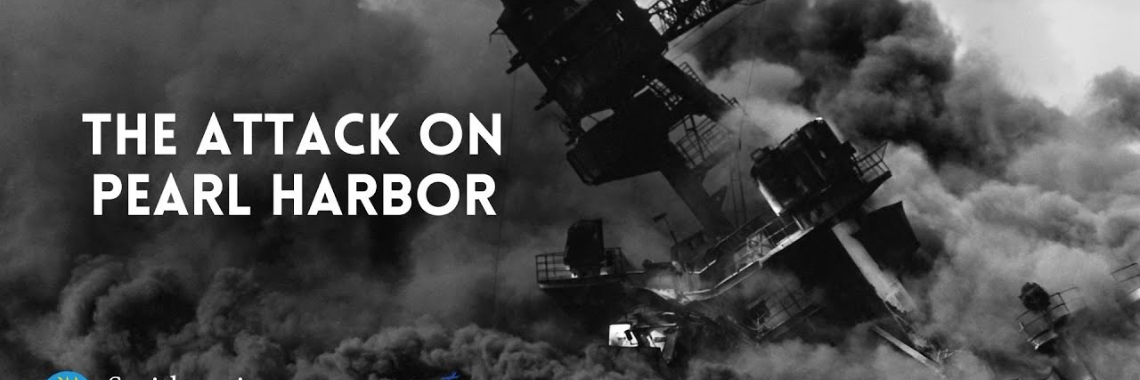Why Did Japan Attack Pearl Harbor
After more than 75 years, the question remains for students of the history of World War Two:
The attack on Pearl Harbor ranks as the most successful military surprise attack in the early years of combined naval/aerial combat. On December 7, 1941, the Imperial Japanese Navy Air Service struck the United States naval base at Pearl Harbor, Hawaii Territory. The Attack on Pearl Harbor on December 7, 1941, directly caused America’s entry into WW2 which led to the eventual launch of the atomic bombs on Hiroshima and Nagasaki, an outcome that spelled disaster for the Japanese.
The Japanese managed to damage almost 20 U.S. naval vessels, of which 8 large battleships, 200 airplanes, and killing over 2,000 Americans, but why did the Japanese attack America in the first place? And what were they trying to achieve by attacking Pearl Harbor, specifically?
The U.S. and Japan had been butting heads for decades and it was inevitable that things would eventually culminate into a war. Japan had imperial ambitions to expand to China to solve some demographical and economical problems and to take over the Chinese import market. When in 1937 Japan decided to declare war on China, America was very against this aggression and responded with trade embargoes and economic sanctions. Specifically, the oil embargo that America organized with the British and the Dutch was a thorn in the side for Japan, which imported 90% of its oil. Without oil Japan’s military could not function and all war efforts would come to an end. Negotiations had been going on for months between Washington and Tokyo, without any resolution, so Japan decided to attack first.
Why Attack Pearl Harbor?
As war was inevitable, Japan’s only chance was the element of surprise and to destroy America’s navy as quickly as possible. Japan wanted to move into the Dutch East Indies and Malaya to conquer territories that could provide important natural resources such as oil and rubber. By destroying a large portion of the American fleet, they hoped to conquer the Philippines and Malaya while America was still recovering from its own damages – simultaneous attacks were launched on these places while Pearl Harbor was taking place.
Let’s return to our main question: why did Japan attack Pearl Harbor? Ultimately, Japan hoped that America would accept defeat and that Japan could create a fortress that would stretch across the whole Pacific Rim.
Roosevelt expected an attack by the Japanese, but conspiracy theories claiming that he knew that they were going to strike Pearl Harbor have been rejected by most scholars. The Government rather expected Japan to attack American targets in Thailand or the Dutch East Indies than a target this close to home. The Chicago Tribune published a top-secret war plan, “Rainbow Five” on December 4, 1941, in which the War Department made preparation arrangements for war with Japan.
Intelligence Warnings of the Attack Before Dec. 7, 1941
The day before the death of Sara Roosevelt, Franklin Roosevelt’s mother, the State Department’s rebuff of Japanese Prime Minister Konoye’s urgent request for a private talk with Roosevelt convinced the Japanese to begin serious plans for an attack.
At a cabinet meeting on September 6, 1941, Admiral Isoroku Yamamoto was told to attack unless Konoye somehow achieved peace terms with the United States that would not spark a revolution at home, an uprising in Korea, or the restoration of Chinese morale. Hirohito had been shot at twice, once by a Japanese communist, once by a Korean nationalist. The better men of two cabinets had been murdered or wounded because they were seen as too accommodating to the foreigners who wanted to colonize Japan or reduce the nation that had never lost a war in modern times to a vulnerable third-rate power. Konoye himself had been threatened with assassination if he made too many concessions, and there had been serious attempts to overthrow the emperor in favor of his brother or his son. Hirohito knew that his dynasty itself could be wiped out like the Romanovs or marginalized, as the Japanese themselves had done to the Korean royalty if he bowed to demands that the Japanese saw as not merely insulting but insane.
Yamamoto, who spoke fluent English, had studied at Harvard, and in happier times had hitchhiked across the United States, knew that Japan could not conquer, or even defeat, the United States. The Japanese grand strategy, if war could not be avoided, was to inflict enough damage and seize enough territory that the Americans would guarantee Japanese sovereignty in return for an armistice and restoration of all or most of what Japan had taken outside Korea and perhaps Manchuria.
Theoretical plans for a Japanese attack on Pearl Harbor had existed for decades. General Billy Mitchell had warned as early as 1924 that the next war would be fought with aircraft carriers. The U.S. Navy’s Admiral Harry Yarnell conducted a simulated attack by carrier-based aircraft in 1932 as part of a war game. The Navy judges ruled that it would have sustained substantial damage if the attack had been genuine, and the attackers won the war game.
Yamamoto had delivered his updated contingency plan for an attack on Pearl Harbor on January 7, 1941, less than a month after the British aerial torpedo attack on Taranto. Minoru Genda, Japan’s genius of planning, called Yamamoto’s initial plan “difficult but not impossible.” More information was needed. By the summer of 1941, Korean patriots who kept an ear to the wall at the Japanese consulate in Honolulu through Korean servants and loyal Japanese-Americans were picking up rumors of intense Japanese interest in the depth of water in the harbor and the strengths and weaknesses of the Army and Navy installations in Hawaii.
Roosevelt’s restriction on Japan’s oil supply shifted Japanese planning into high gear. War was now the only alternative to economic strangulation and political revolution.
In the final months leading up to the attack, the U.S. government issued a memorandum stating, “The Japanese government does not desire or intend or expect to have forthwith armed conflict with the United States. . . . Were it a matter of placing bets, the undersigned would give odds of five to one that Japan and the United States will not be at ‘war’ on or before March 1 (a date more than 90 days from now, and after the period during which it has been estimated by our strategists that it would be to our advantage for us to have ‘time’ for further preparation and disposals).”
On December 1, 1941, the emperor met with his privy council. “It is now clear that Japan’s claims cannot be attained through diplomatic means,” Tojo said. The emperor—perhaps more gun-shy than the elder statesmen—asked for a vote. The cabinet voted unanimously for war. Hirohito agreed. The Japanese fleet was told to attack Pearl Harbor on December 7 unless it received a last-minute cancellation because of a sudden change in America’s attitude. Kurusu and Nomura—who had been sincere in seeking peace until they received the Hull note—were told to stall for time. Tojo summed up the situation: Japan, the one Asian, African, or South American nation that had modernized instead of being colonized, could not accept the American demands without riots at home, revolt in Korea, and reversal in Manchuria. “At this moment,” he declared, “our Empire stands on the threshold of glory or oblivion.”
The Forgotten Reasons Japan attacked Pearl Harbor
![pearlharbor]()
Most Americans don’t remember. Those who do probably recall the explanation taught in high school: the militaristic Japanese government planned to take over the Pacific, realized that the fleet at Pearl Harbor represented a major obstacle to that goal, and incorrectly predicted that the United States would not have the stomach to fight a protracted conflict. This mistaken assumption led to a four-year war in which two million Japanese lost their lives and much of the country was reduced to rubble.
This summary is basically correct. What is less well known, however, is that America’s economic policy towards Japan played a crucial role in the decisions that led to the attack. In the years before Pearl Harbor, President Franklin D. Roosevelt and Secretary of State Cordell Hull became increasingly concerned with Japan’s aggressive expansion in Asia and the Pacific. To combat it, the U.S. government pursued a strategy of trade restrictions and sanctions on Japan, hoping that the economic pressure would force it to halt its conquests without directly involving America in a war.
The U.S. sanctions against Japan achieved its economic goal by causing resource shortages in vital areas and would have curtailed Japan’s ability to wage war in the medium- to long-term. However, on a strategic level, the sanctions were not successful. Roosevelt and Hull had hoped that they could pressure Japan into accepting a diplomatic solution to the embargo. Instead, Japan found a military solution: they knocked out the American fleet at Pearl Harbor and went on a mad dash across the Pacific Ocean, quickly making up for lost U.S. imports with captured British and Dutch raw materials. Seventy-nine years after the attack, as successive administrations pile economic sanctions on America’s adversaries in the hope that doing so can correct their malign behavior, the lessons from the lead-up to Pearl Harbor are worth remembering.
Lessons to Be Learned
Revisionist American historians and far-right Japanese groups contend that the United States left Japan with no choice but to take action. This is not exactly accurate, but it contains a kernel of truth. The choice that Roosevelt offered Japan was binary: either it could accede to American demands, or it could launch a full-scale war. American strategists, including several admirals and America’s ambassador in Tokyo, Joseph Grew, warned that Japan might try the latter. However, given America’s vast advantages in population and economic power, they knew that this would likely end in suicide—and were therefore caught off-guard when Japan chose suicide.
America has come a long way since 1941. A Pearl Harbor-type attack that could cripple U.S. military operations for months on end is exceptionally unlikely to occur. Moreover, nuclear weapons have made another total war between great powers unthinkable. However, analogies to the pre-war U.S.-Japan dynamic exist. Modern Iran has undeniable similarities with Imperial Japan—it, too, is a former U.S. ally taken over by zealous militarists who are attempting to expand beyond their borders.
Thus, the lessons of the run-up to World War II provide a cautionary example. The United States is dealing with Iran in much the same way as it tried to deal with Japan by piling on sanctions and restricting the nation’s imports. As with Japan, this strategy seems to be achieving its most basic goals; Iran’s economy has contracted, and its payments to its foreign proxies have sharply decreased. However, as sanctions have increased, the ruling regime has grown steadily more fanatical, more bellicose, and less willing to seek compromise. This is not good. A war with Iran, which is a distinctly possible outcome of the sanctions regime, would result in an American victory, but it would come at a massive cost. The United States won the Pacific War but hundreds of thousands of American lives were lost in the process.
This is not to suggest that the United States should leave Iran alone to pursue regional mayhem. However, if there is one lesson to be learned from the sanctions on Japan, it is that it is dangerous to force another nation into a binary choice between two bad options. If given the choice between a political settlement regarded as a humiliating submission to foreign demands, or else a doomed and possibly suicidal war, some nations will choose the war.
Facts Of Pearl Harbor
![pearlharbor]()
On December 7, 1941, the Japanese military launched a surprise attack on the United States Naval Base at Pearl Harbor, Hawaii. Since early 1941 the U.S. had been supplying Great Britain in its fight against the Nazis. It had also been pressuring Japan to halt its military expansion in Asia and the Pacific. With the Japanese attack on Pearl Harbor, the U.S. could no longer avoid an active fight. On December 8, U.S. President Franklin Delano Roosevelt asked Congress for and received a declaration of war against Japan. On December 11, Germany and Italy, allied with Japan, declared war on the U.S. The United States had entered World War II.
Japanese Admiral Isoroku Yamamoto conceived the Pearl Harbor attack and Captain Minoru Genda planned it. Two things inspired Yamamoto’s Pearl Harbor idea: a prophetic book and a historic attack. The book was The Great Pacific War, written in 1925 by Hector Bywater, a British naval authority. It was a realistic account of a clash between the United States and Japan that begins with the Japanese destruction of the U.S. fleet and proceeds to a Japanese attack on Guam and the Philippines. When Britain’s Royal Air Force successfully attacked the Italian fleet at Taranto on November 11, 1940, Yamamoto was convinced that Bywater’s fiction could become reality. On December 6, 1941, the U.S. intercepted a Japanese message that inquired about ship movements and berthing positions at Pearl Harbor. The cryptologist gave the message to her
superior who said he would get back to her on Monday, December 8. On Sunday, December 7, a radar operator on Oahu saw a large group of airplanes on his screen heading toward the island. He called his superior who told him it was probably a group of U.S. B-17 bombers and
not to worry about it. The Japanese attack on Pearl Harbor began at 7:55 that morning. The entire attack took only one hour and 15 minutes. Captain Mitsuo Fuchida sent the code message, “Tora, Tora, Tora,” to the Japanese fleet after flying over Oahu to indicate the Americans had been caught by surprise. The Japanese planned to give the U.S. a declaration of war before the attack began
so they would not violate the first article of the Hague Convention of 1907, but the message was delayed and not relayed to U.S. officials in Washington until the attack was already in progress. The Japanese strike force consisted of 353 aircraft launched from four heavy carriers. These included 40 torpedo planes, 103 level bombers, 131 dive-bombers, and 79 fighters. The attack also consisted of two heavy cruisers, 35 submarines, two light cruisers, nine oilers, two battleships, and 11 destroyers. The attack killed 2,403 U.S. personnel, including 68 civilians, and destroyed or damaged 19 U.S. Navy ships, including 8 battleships.
The three aircraft carriers of the U.S. Pacific Fleet were out to sea on maneuvers. The Japanese were unable to locate them and were forced to return home with the U.S. carrier fleet intact.









then €5.99/month after 14 days
Start your 14-day free trial now to publish your sponsored content. Cancel anytime.